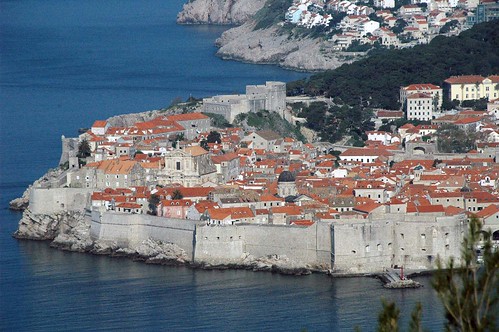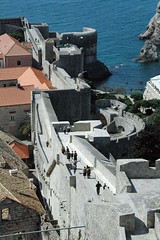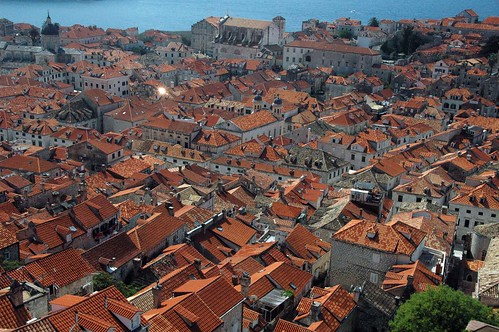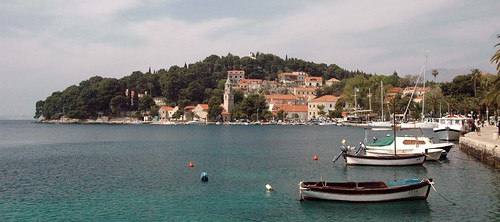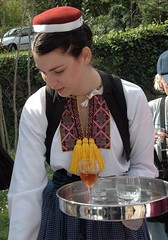Thursday, April 16, 2009
Dubrovnik, Croatia
Walking along Dubrovnik's Stradun, you can see pock marks in the marble blocks of the pavement, shallow indentations radiating stress fractures. They look like fossils. In fact they are pits made by Milosevic’s mortar shells. It is hard for me to imagine bombs raining down on this idyllic town. The Stradun sits atop a filled in canal that once separated the mainland from the island of Ragusa. The marble pavement was laid down in 1468, 308 years before the Declaration of Independence.
We make the usual rounds with the guides, the Franciscan monastery, the Onofrio de la Cava fountain, the Museum, the walk along the walls of the city.
Kristina, our guide, tells us that Croatia is 86% Catholic. This might make you think that this is a very devout country. I ask her what percentage of that population goes to church on Sunday. She pauses for a moment and then says about 40%.
“Are you a Catholic?” I ask.
She nods.
“How often do you go to church?”
“Only at Easter and Christmas time,” she says.
I believe her. France, like Croatia, is 85% percent Catholic. There an even smaller percentage of the population attends church regularly. Compare that to the United States. We have more religions than Carter has liver pills. Church attendance in America is far higher than in France or, taking Kristina at face value, Croatia. Why should that be?
One of the major functions of a religion is to provide people with a community of like people. It makes one feel safer. In countries like France or Croatia where the vast majority of the people share the same religion, it is easy to feel part of the same community. Hence the need to congregate inside the same building is not acute. In countries as big as the United States it is far more difficult for Americans to feel part of a single community. So we fracture and form smaller, more recognizable communities; hence the multiplicity of religions.
How does Albania with its 70% Muslim population fit into this picture? I’m not sure. For one thing it is the most un-Muslim Muslim society I have ever been in. I didn’t see a single woman in a burka and only one school child wearing a headscarf. Our guide, Kela, tells us that everyone drinks and smokes, Muslim or no. It is hard to say in what sense this Muslim society is Muslim. Even Al Quaeda threw in the towel after trying for three years to recruit for its jihad. But I’ll bet a dollar to a dime that church attendance in Albania is down around the French numbers. They don’t need a church to tell them what society they belong to.
In the afternoon we drive to Cavtat, the forerunner of Dubrovnik for a short stroll around the town and then a visit to a flour mill for a taste of Croatian walnut and cherry liquors and Croatian style raki. We have provolone cheese and prosciutto in a nearby bower and imagine we are alreadu in Italian.
The Ljuta River powers the flourmill. A pull of a cord and the operator engages a waterwheel that turns a grindstone that turns corn into flour. He tells me that this kind of flour making will come back. Just now people buy their bread and polenta at the mini market. Soon a taste for natural food will return and maybe as many as 5% of the population--that’s his figure--will return to the flourmills of yesteryear. Is this the Croatian Mr. Whole Foods speaking?
One of the servers is named Ivana. I didn’t ask her age. She couldn’t have been more than twenty years old. She tells me she is from Gruda. She says she isn’t married. When I ask her if she wants to be, she says each year less and less. When I ask why, she says it is difficult to find the right kind of man. When I ask what kind that is, she says one that will help with the dishes.

